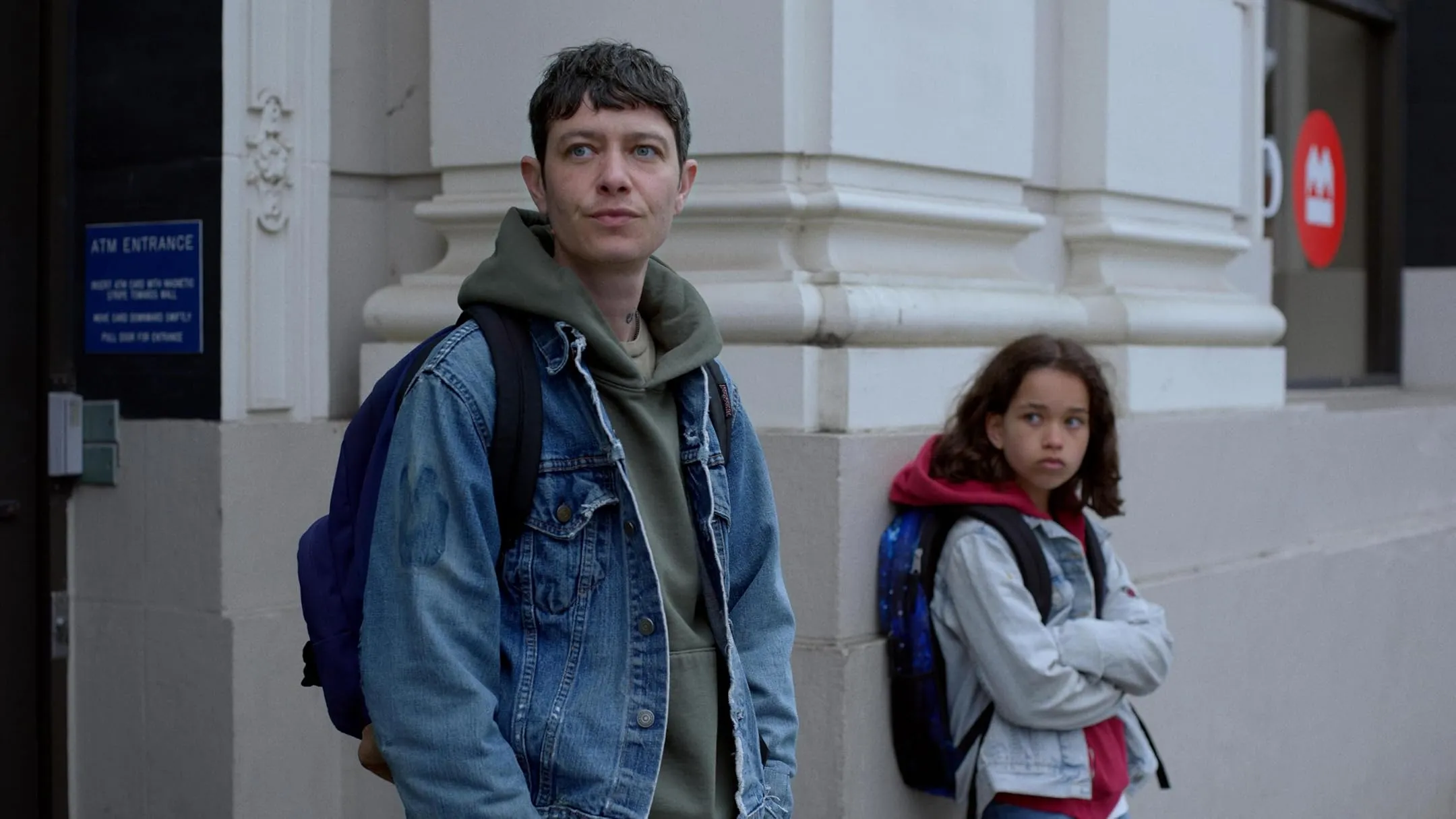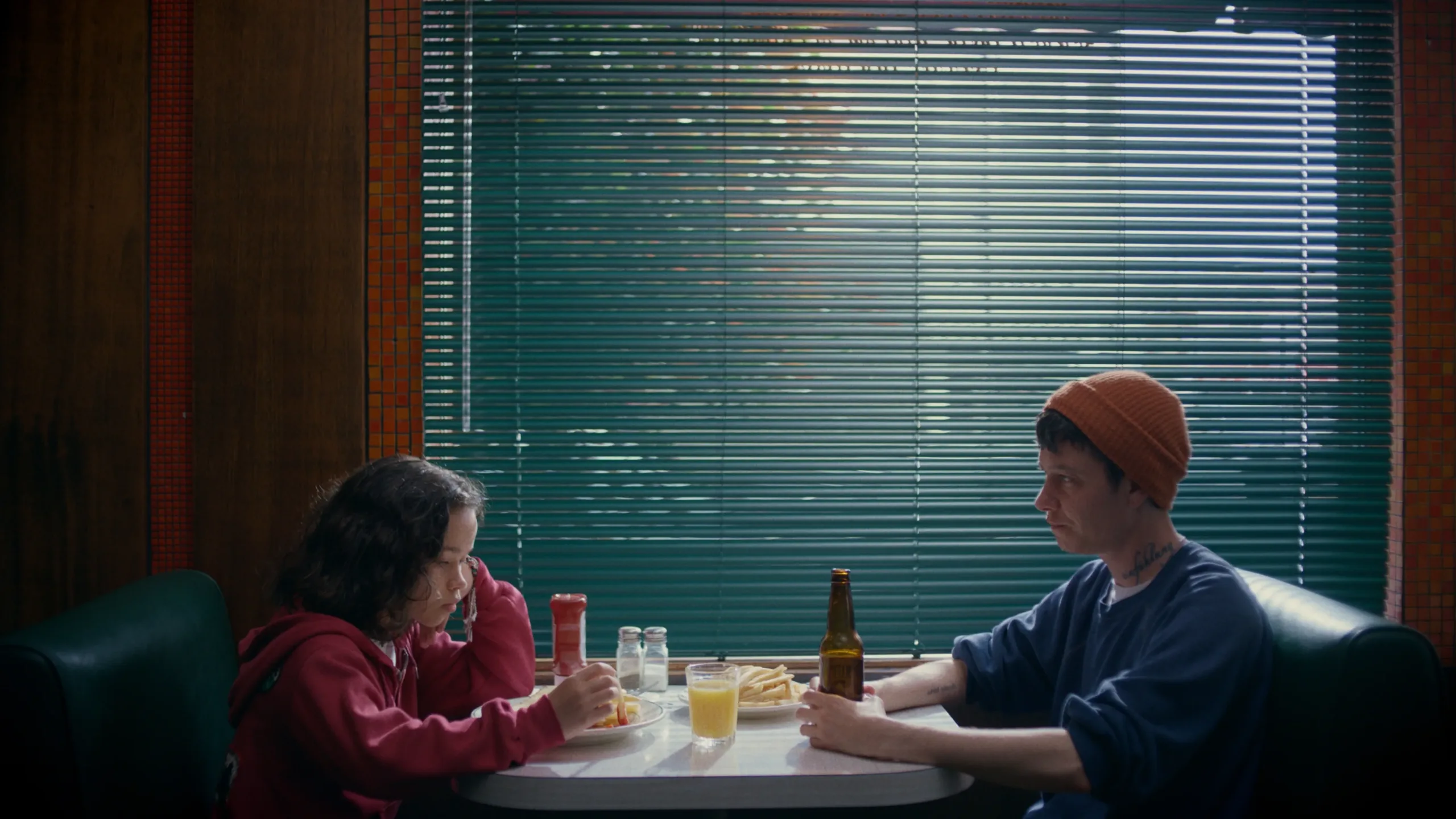Cass drifts through San Francisco like a ghost tethered to memory. A nonbinary caretaker by fate and choice, they juggle restaurant orders and a child’s silent pleas. When Ari’s mother disappears, Cass inherits more than responsibility—an unwelcome mirror of their own past abandonment.
The film opens with hushed cityscapes: cranes slicing into fog, neon halos flickering in half-empty streets. These images breathe as characters themselves, reflecting the tension between gleaming ambition and lives left behind. In one frame, Cass pauses at a shuttered queer bar, the marquee’s darkened letters rattling in the wind. Silence speaks there—an elegy for lost communities.
Ari arrives like an echoed question: Can healing begin when two restless souls collide? Their interactions unfold in punctuated motions—Cass offering a hesitant smile, Ari turning away, only to return moments later with a toy pressed to her chest. These quiet exchanges carry the weight of existential longing: the yearning to belong, to be witnessed.
Under Lena Raine’s score—where electronic tremors entwine with orchestral breaths—the city pulses as both refuge and labyrinth. Cass moves through its corridors, half-hidden, half-seeking. In these opening moments, Outerlands promises a voyage into the spaces between connection and solitude, where every glance might become a bridge.
Fractured Horizons
In Outerlands, San Francisco emerges as a dialectic of aspiration and abandonment. Towering glass facades reflect dreams of innovation even as their mirrored surfaces cast shadows over rent-controlled brownstones. Cass threads through this landscape, their silhouette framed by neon signs and rusted fire escapes in the same breath. The city’s vertical ambitions stand atop the precarious foundations of those who pay the price of progress.
Daily life here is a ledger of small defeats. Cass splits hours between fine-dining tables and a makeshift babysitting station, then slips into back-alley corners to deal substances just to balance the books. Each paycheck dissolves into rent, utilities, the silent tax of gentrification. Meanwhile, queer enclaves flicker out: one neighborhood bar demands exorbitant cover fees, another shutters overnight. In these ghostly interiors, laughter echoes like a fragment of a half-remembered song.
The term “Outerlands” hovers over the story like an incantation. More than a label, it conjures a territory at the edge of belonging—a digital cartridge stowed away in Cass’s closet, where an astronaut searches endlessly for home. That pixelated odyssey parallels the film’s human journey: how do you map a path back to yourself when your coordinates have shifted?
Political threads are woven into everyday details. A landlord’s curt eviction notice, a bank teller’s tired apology, a taxi driver’s offhand remark about rising fares—all register as micro-revolts against a city that hears its own heartbeat but not the whispers of its margins. No speech rings out from a rooftop; instead, revolt simmers in the quiet desperation of characters who must remap their lives, day by day. Unspoken questions drift through sunlit laundromats and dimly lit apartments: Who claims this space? Who is erased by its advance?
In these fractured horizons, Outerlands asks whether home is a fixed coordinate or an act of reckoning—with loss, with memory, with the unrelenting logic of a city in flux.
Interior Topographies
Cass inhabits the frame like a quiet tremor—static close-ups linger on their downcast eyes, the muted grays of a studio apartment pressing in around them. There is a deliberate economy in every gesture: a trembling hand over an unopened letter, a measured sip of beer that tastes of grief. Depression coils beneath the surface, where survivor’s guilt and the vigilant awareness of a nonbinary body in public converge into an unspoken tension. Dillon shapes these interior fissures with precision, guiding Cass from self-imposed exile toward the hesitant warmth of another’s gaze.
Ari stands in stark counterpoint. Ridley Asha Bateman’s presence pulses with contradictory forces: a child’s bristling independence contrasted against an almost feral clutching of a battered toy. She speaks in truncated sentences, as if each word might break the fragile bond she’s forced to forge. In her silences, history seeps through: the void left by an absent mother, the brittle armor of a child compelled to grow up too soon.
Secondary characters flicker through their periphery like guardians of half-forgotten truths. Emile emerges in a haze of queer nostalgia—his laughter evoking smoky dance floors where solidarity once thrived. He reminds Cass of nights when belonging felt tangible. Denise, in her soft-spoken pragmatism behind the bank counter, offers a sliver of maternal grace—a reminder that trust need not arrive fully formed. Kalli remains offscreen, her disappearance the catalyst for Cass and Ari’s fragile union; in her absence, hope and fear entwine into a single question: Can two wounded souls rebuild what’s been lost?
In these performances, the film resolves neither plot nor pain; instead, it traces the porous boundaries between solitude and kinship. Every close-up, every withheld glance, evokes an existential ache—a longing for connection that might never be complete, yet persists in the spaces between words.
Palimpsests of the Self
Abandonment threads through Outerlands like an invisible scar. Cass’s early traumas reverberate in Ari’s wary gaze, as if history folds back on itself. Two solitary figures orbit each other until their shared void becomes a fragile anchor. In those quiet moments—when a reluctant smile breaks Catharsis’s gravity—they forge a found family, stitching frayed edges of selfhood together.
Escapism arrives in unexpected guises. The pixelated cosmos of the Outerlands cartridge glows on Cass’s screen—a retro sanctuary where an astronaut retraces lost circuits in search of home. These digital voyages mirror Cass’s own detours through memory’s labyrinth. Alcohol slides down in parallel rituals, each sip a temporary lull against the ache of emptiness. Both intoxicants and joysticks offer fleeting moments of control in a world defined by unpredictability.
Identity and visibility collide on San Francisco’s streets. Every misgendered address becomes a razor’s edge, each affirming pronoun a whispered benediction. Cass moves through crowds like a shadow uncertain of its shape, hunted by the city’s erasure of queer lineage. Yet fleeting affirmations—a friend’s careful correction, Denise’s warm recognition—shine like constellations against an ever-shifting skyline.
Healing hovers on the horizon of the inner child. Ari’s grasp on her tattered teddy bear and Cass’s dorm-like apartment strewn with childhood relics testify to unprocessed grief. Those objects carry the weight of years unspoken. When Denise presses a comforting hand against Cass’s, we glimpse the first tremors of self-compassion. A torn sticker is peeled back, revealing the name beneath. The act feels sacramental—an admission that wounds can be tended if only we allow another to steady our trembling hands.
Anatomy of Perception
Lucia Zavarcikova’s lens moves like a whisper through flesh and steel. Static close-ups settle on Cass’s face as though time itself has grown weary, each frame a portal to interior storms. Elsewhere, the camera drifts—lingering on striated dawn light across empty streets, then slipping into cramped hallways where neon spills like broken promises. These languid montages punctuate the story’s pulse, offering respite from urgency while deepening its undercurrent of unease.
Editing unfolds with deliberate restraint. Pauses stretch into moments of reckoning: a hand suspended over a phone, a breath caught between two worlds. Daily routines—sorting receipts, folding laundry—are intercut with fleeting dreamscapes, creating a rhythm that feels organic yet dreamlike. In this measured tempo, emotion isn’t summoned; it seeps in, one exhalation at a time.
Sound becomes a character in its own right under Lena Raine’s direction. An electronic hum reverberates beneath orchestral swells, as if machinery and heart share the same mournful secret. The clatter of laundromat drums, distant traffic murmurs, even the soft click of a video-game cartridge: each diegetic note layers meaning, transforming pastime into prophecy.
Production design whispers of lives half-lived. Cass’s apartment, sparse and dorm-like, hides a trove of childhood relics—tattered stickers, console shells, a lone stuffed animal. The restaurant and laundromat stand in stark contrast: one polished for patrons of privilege, the other a dim refuge for those propping up a crumbling edifice. These spaces map social fractures without a single written sign.
In this confluence of image, sound, and space, Outerlands crafts a cinematic dialect—one that speaks of solitude, memory, and the fragile architectures we erect to shelter our souls.
Thresholds of Trust
Cass and Ari begin as two strangers orbiting the same void. Cass offers a half-hearted half-smile, as if uncertain the gesture belongs to them; Ari answers in clipped syllables, each word a shield. Their silence stretches like an empty hallway, echoing with unasked questions.
Then something shifts. A shared game on a cracked phone screen becomes a fragile communion. Laughter, tentative and uneven, bubbles up—an unexpected tremor in calm air. In those moments, fingertip brushes on a controller become more than input; they become unspoken invitations: “I see you here.”
Yet trust is never a straight line. After a flicker of connection, Cass retreats into the comfort of a cold bottle, the room spinning with old regrets. Ari recoils into defensive posture, arms crossed as though she might vanish if touched. Their bond trembles under the weight of relapse, as if past wounds can pull them back into lonely orbits.
In the film’s final tableau, Cass and Ari sit side by side on a worn couch. A shared glance lingers, eyes meeting across a gulf both perilous and full of promise. Beyond the window, cranes carve the sky—a reminder that nothing stays fixed. Hope unfolds in the quiet knowledge that, despite uncertainty, each gesture toward one another redraws the lines of their shared world.
Full Credits
Director: Elena Oxman
Writer: Elena Oxman
Producers: Elena Oxman, Marc Smolowitz, Asia Kate Dillon, Allison Estrin, Henry Russell Bergstein
Executive Producers: David Brind, Marc Smolowitz, Julien Swanson, Jessica Christiansen
Cast: Asia Kate Dillon, Louisa Krause, Ridley Asha Bateman, Lea DeLaria, Daniel K. Isaac, Melinda Meeng, Allie Heng, Winter Dewitt, Safiya Fredericks, Sedrick Cabrera
Director of Photography (Cinematographer): Lucia Zavarcikova
Composer: Lena Raine
The Review
Outerlands
Outerlands unfolds as a quiet exploration of loneliness and the fragile bonds that heal it. Asia Kate Dillon and Ridley Asha Bateman deliver luminous performances, their silences rich with unspoken yearning. Elena Oxman’s direction—enhanced by Lucia Zavarcikova’s still compositions and Lena Raine’s spectral score—traces grief and longing in equal measure. The film asks whether two wounded souls can shape a shared sanctuary amid a city that has forgotten them. Its lingering images and subtle rhythms stay with you long after the credits roll.
PROS
- Poetic imagery that lingers
- Nuanced, deeply felt performances
- Atmosphere suffused with melancholy
- Themes of identity and belonging
- Score that melds heartbeats and city rhythms
CONS
- Pacing can feel glacial
- Emotional stakes emerge slowly
- Moments of narrative ambiguity


















































